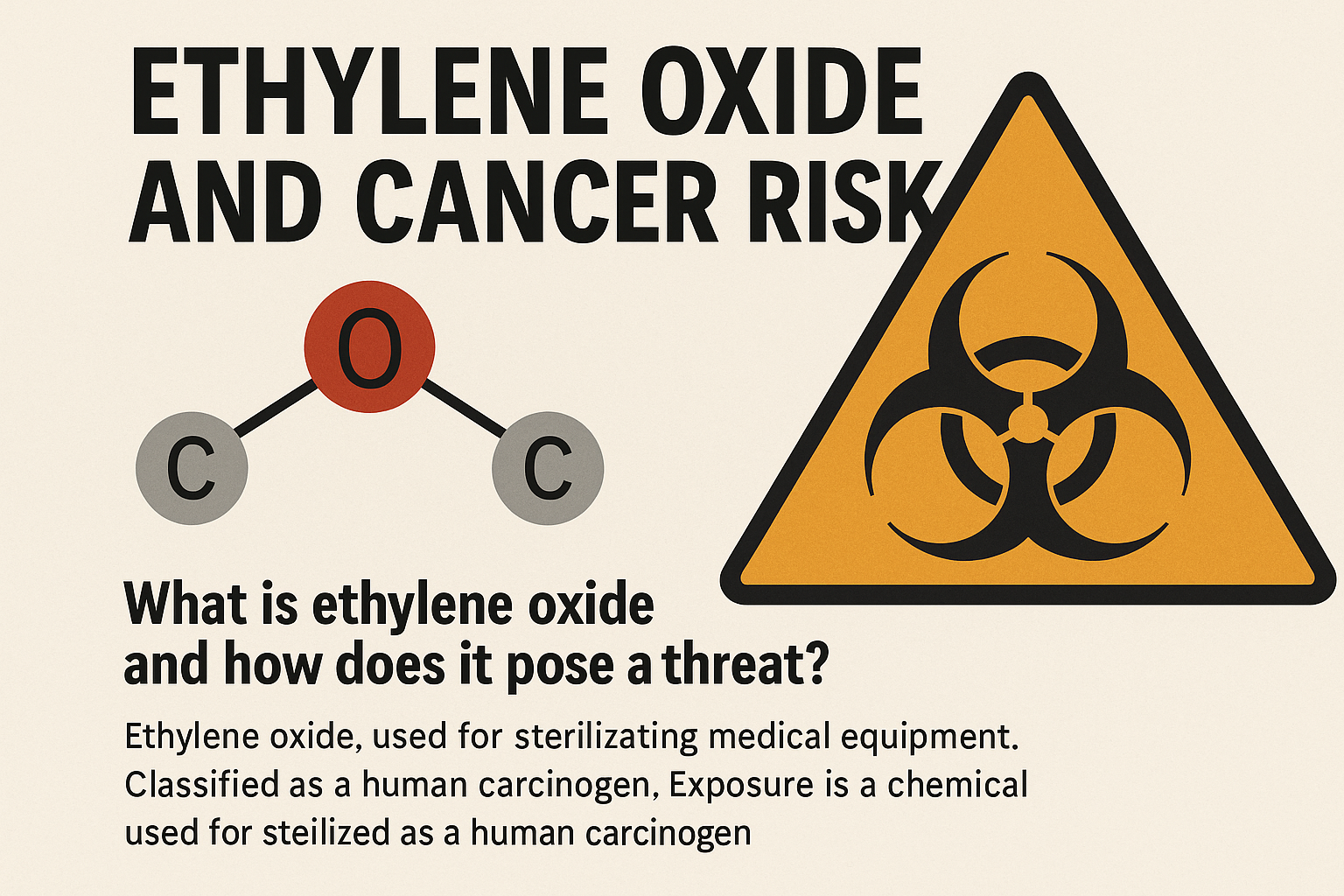Ethylene oxide (EtO) is a colorless, flammable gas widely used in industrial processes, particularly for sterilizing medical equipment and supplies. While it plays a critical role in healthcare by ensuring the safety of devices like syringes and surgical kits, its emissions from sterilization plants have raised serious public health alarms. Classified as a known human carcinogen, EtO exposure has been linked to increased risks of various cancers, affecting not only workers but also residents living near emitting facilities. This article delves into the cancer side effects of EtO, supported by robust scientific studies and epidemiological data. As evidence mounts, EtO is emerging as a potential new frontier in mass tort litigation, offering opportunities for affected individuals to seek justice against negligent companies. For those impacted, understanding these risks could be the first step toward accountability.
What is Ethylene Oxide and How Does It Pose a Threat?
Ethylene oxide is produced in large quantities for chemical manufacturing and sterilization. In sterilization plants, it’s used to fumigate heat-sensitive medical products, penetrating packaging to kill microbes without damaging the items. However, during this process, EtO can escape into the air through vents, leaks, or improper handling, leading to environmental contamination.
The U.S. Environmental Protection Agency (EPA) identifies sterilization facilities as major sources of EtO emissions, with some plants releasing thousands of pounds annually. These emissions can linger in the air, soil, and water, exposing nearby communities to low-level, chronic inhalation risks. Unlike acute occupational exposures, community exposure is insidious, often going unnoticed until health issues arise. The EPA’s assessments highlight that even low concentrations, such as 0.1 parts per trillion, can elevate lifetime cancer risks. This is particularly concerning for vulnerable populations, including children, who may face higher risks due to developing bodies and longer potential exposure durations.
Cancer Risks Linked to Ethylene Oxide Exposure
Scientific consensus, backed by agencies like the International Agency for Research on Cancer (IARC) and the EPA, confirms EtO as carcinogenic to humans. It operates through a mutagenic mode of action, damaging DNA and leading to uncontrolled cell growth. Studies show no safe threshold for exposure, with risks accumulating over time. Below, we explore specific cancers associated with EtO, drawing from occupational cohorts, animal experiments, and community-based research.
Lymphohematopoietic Cancers: Lymphoma, Leukemia, and Non-Hodgkin Lymphoma
Lymphoma and leukemia are among the most consistently linked cancers to EtO exposure. Occupational studies of workers in sterilization and chemical plants reveal elevated risks, particularly for lymphohematopoietic malignancies.
A landmark cohort study by the National Institute for Occupational Safety and Health (NIOSH) followed 18,235 EtO-exposed workers from 1940 to 1998. It found increased mortality from hematopoietic cancers, including non-Hodgkin lymphoma (NHL) and leukemia, with a dose-response relationship: higher cumulative exposures correlated with greater risks. Specifically, the standardized mortality ratio (SMR) for lymphohematopoietic cancers was 1.55 (95% CI: 1.09-2.13) in the highest exposure group. An earlier Swedish cohort of 709 workers exposed to EtO reported excess leukemia (SMR 9.2) and stomach cancer, suggesting a broader carcinogenic impact.
Animal studies reinforce these findings. Rats exposed to EtO via inhalation developed leukemia in females and peritoneal mesotheliomas in males, demonstrating clear carcinogenic potential. The IARC’s evaluation, based on sufficient animal evidence and limited human data, classifies EtO as Group 1 (carcinogenic to humans), emphasizing strong mechanistic evidence of genotoxicity.
In community settings, proximity to EtO-emitting facilities heightens NHL risks. A large U.S. cohort (NIH-AARP Diet and Health Study) of over 450,000 participants linked higher EtO emissions within 10 km of residences to a 7% increased NHL risk (HR 1.07, 95% CI: 0.95-1.20), though not statistically significant overall, with stronger associations for subtypes like chronic lymphocytic leukemia.
Breast Cancer: A Growing Concern for Women
Breast cancer, particularly in women, shows strong associations with EtO exposure. The NIOSH cohort reported elevated breast cancer incidence (SIR 1.87, 95% CI: 1.12-2.93) and mortality among highly exposed female workers, with risks rising 2-3 fold in the top exposure tertile. A 62-year follow-up of this cohort confirmed these findings, supporting EtO as a breast carcinogen even at lower exposures.
Environmental studies extend this to communities. In the NIH-AARP cohort, living within 3-5 km of EtO facilities increased breast cancer risk by 28-60% (HR 1.28-1.60), with stronger links for ductal carcinoma in situ (DCIS), a non-invasive form. The Nurses’ Health Study II found a similar non-significant increase (HR 1.04, 95% CI: 0.94-1.15) for invasive breast cancer.
Mechanistically, EtO alkylates DNA, forming adducts that disrupt hormone regulation, potentially exacerbating estrogen-sensitive breast cancers. The EPA’s IRIS assessment supports this, estimating a unit risk of 3 × 10^-3 per µg/m³ for inhalation cancer risk.
Other Cancers: Stomach, Myeloma, and Beyond
Stomach cancer has been observed in some cohorts. The Swedish study noted excess mortality (SMR 3.4), though confounded by co-exposures. Myeloma and other lymphohematopoietic cancers show positive trends in meta-analyses.
A systematic review adhering to PRISMA guidelines confirmed EtO’s carcinogenicity, integrating human, animal, and mechanistic data. Colorado’s state health department, responding to community concerns, found small increases in EtO-linked cancers near facilities.
Evidence from Key Studies and Assessments
Occupational Cohort Studies
The NIOSH cohort remains the gold standard, with extended follow-ups showing persistent excesses in lymphohematopoietic and breast cancers. A reevaluation of historical exposures in this cohort adjusted for underestimations pre-1978, strengthening risk estimates.
Swedish and British cohorts corroborate these, with one showing excess mortality from tumors and circulatory diseases among full-time exposed workers.
Community and Environmental Studies
The EPA’s 2020 risk assessment identified unacceptable cancer risks near most commercial sterilizers, with some communities facing risks up to 200 in a million. By 2024, regulations reduced emissions by 90% at 22 of 23 high-risk facilities, but legacy exposures persist.
Animal and Mechanistic Evidence
Rodent studies show multisite tumors, supporting human relevance. EtO’s genotoxicity—forming DNA adducts—explains its broad carcinogenic effects.
Affected Communities and Sterilization Plants
Over 100 EtO sterilization facilities operate nationwide, often in densely populated areas. Hotspots include Atlanta, GA; Willowbrook, IL; and Laredo, TX, where emissions have led to elevated community risks. Low-income and minority communities are disproportionately affected, amplifying environmental justice concerns.
Legal Implications: EtO as a New Mass Tort
Mounting evidence has spurred litigation. In Georgia, a jury awarded $20 million in compensatory damages against C.R. Bard for EtO emissions causing harm. Sterigenics faces hundreds of suits in Illinois and Georgia, alleging negligent releases leading to cancers like leukemia. New Jersey residents near facilities in Linden and Franklin have filed claims for EtO-induced cancers.
Sotera Health, parent of Sterigenics, defends against personal injury and environmental claims, highlighting the growing tort landscape. With multimillion-dollar verdicts and EPA scrutiny, EtO mirrors past mass torts like asbestos, offering avenues for compensation.
Conclusion
Ethylene oxide’s cancer risks—backed by decades of studies—are undeniable, affecting workers and communities alike. From lymphoma and leukemia to breast cancer, the evidence demands action. As a potential mass tort, EtO cases could provide justice for victims. If you’ve lived near a sterilization plant or worked with EtO and developed cancer, contact Mass Tort Ad Agency today to explore your options. Don’t let corporate negligence go unchecked your health, and future, depend on it.



